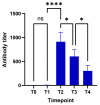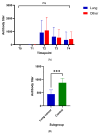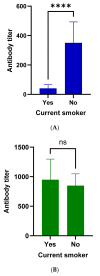Assessment of Seroconversion after SARS-CoV-2 Vaccination in Patients with Lung Cancer
- PMID: 35455367
- PMCID: PMC9031406
- DOI: 10.3390/vaccines10040618
Assessment of Seroconversion after SARS-CoV-2 Vaccination in Patients with Lung Cancer
Abstract
Background: SARS-CoV-2 mortality rates are significantly higher in patients with lung cancer compared with the general population. However, little is known on their immunization status after vaccination. Methods: To evaluate the humoral response (seroconversion) of patients with lung cancer following vaccination against SARS-COV-2 (Group A), we obtained antibodies against SARS-CoV-2 spike (S) protein both at baseline and at different time points after the first dose of SARS-CoV-2 vaccine (two to three weeks [T1], six weeks ± one week [T2], 12 weeks ± three weeks [T3], and 24 weeks ± three weeks [T4]). Antibodies were also acquired from a control cohort of non-lung cancer patients (Group B) as well as a third cohort containing healthy controls (Group C) at all time points and at T4, respectively, to make comparisons with Group A. Analysis of antibody response at different time points, association with clinicopathologic parameters, and comparisons with control groups were performed. Results: A total of 125 patients with lung cancer were included in the analysis (96 males [74.3%], median age of 68 years [46−91]. All study participants received two vaccine doses (BNT162b2, mRNA-1273, AZD1222). Analysis of anti-SARS-CoV-2 S antibody titers showed minimal response at T1 (0.4 [0.4−48.6] IU/mL). Antibody response peaked at T2 (527.0 [0.4−2500] IU/mL) and declined over T3 (323.0 [0.4−2500] IU/mL) and T4 (141.0 [0.4−2500] IU/mL). Active smokers had lower antibody titers at T2 (p = 0.04), T3 (p = 0.04), and T4 (p < 0.0001) compared with former or never smokers. Peak antibody titers were not associated with any other clinicopathologic characteristic. No significant differences were observed compared with Group B. However, lung cancer patients exhibited significantly decreased antibody titers compared with Group C at T4 (p < 0.0001). Conclusions: Lung cancer patients demonstrate sufficient antibody response six weeks after the first dose of vaccine against SARS-CoV-2 when vaccinated with two-dose regimens. Rapidly declining antibody titers six weeks after the first dose underline the need for a third dose three months later, in patients with lung cancer, and especially active smokers.
Keywords: COVID-19; SARS-CoV-2; antibodies; humoral immunity; lung cancer; seroconversion; vaccination.
Conflict of interest statement
The authors declare no conflict of interest for this study. Roche diagnostics had no role in the design, execution, interpretation or writing of the study.
Figures



Similar articles
-
Six-month humoral response to mRNA SARS-CoV-2 vaccination in patients with multiple sclerosis treated with ocrelizumab and fingolimod.Mult Scler Relat Disord. 2022 Apr;60:103724. doi: 10.1016/j.msard.2022.103724. Epub 2022 Mar 4. Mult Scler Relat Disord. 2022. PMID: 35272145 Free PMC article.
-
Humoral immune response after different SARS-CoV-2 vaccination regimens.BMC Med. 2022 Jan 21;20(1):31. doi: 10.1186/s12916-021-02231-x. BMC Med. 2022. PMID: 35057798 Free PMC article.
-
Quantitative Analysis of SARS-CoV-2 Antibody Levels in Cancer Patients Post Three Doses of Immunization and Prior to Breakthrough COVID-19 Infections.Curr Oncol. 2022 Sep 28;29(10):7059-7071. doi: 10.3390/curroncol29100554. Curr Oncol. 2022. PMID: 36290831 Free PMC article.
-
Evolution of anti-SARS-CoV-2 spike protein titers after two-dose of COVID-19 vaccination among people living with HIV.J Virus Erad. 2022 Dec;8(4):100308. doi: 10.1016/j.jve.2022.100308. Epub 2022 Dec 13. J Virus Erad. 2022. PMID: 36531082 Free PMC article.
-
Durability of Antibody Response Six Months After Two-Dose SARS-CoV-2 mRNA Vaccination in Patients with Cirrhosis.Gastro Hep Adv. 2023 Apr 5;2(6):758-60. doi: 10.1016/j.gastha.2023.03.025. Online ahead of print. Gastro Hep Adv. 2023. PMID: 37360678 Free PMC article. Review. No abstract available.
Cited by
-
Immune response of COVID-19 vaccines in solid cancer patients: A meta-analysis.Hum Vaccin Immunother. 2024 Dec 31;20(1):2357424. doi: 10.1080/21645515.2024.2357424. Epub 2024 May 24. Hum Vaccin Immunother. 2024. PMID: 38785118 Free PMC article.
-
Cancer Patients and the COVID-19 Vaccines: Considerations and Challenges.Cancers (Basel). 2022 Nov 16;14(22):5630. doi: 10.3390/cancers14225630. Cancers (Basel). 2022. PMID: 36428722 Free PMC article. Review.
-
Impact of coronavirus disease 2019 on lung cancer patients: A meta-analysis.Transl Oncol. 2023 Feb;28:101605. doi: 10.1016/j.tranon.2022.101605. Epub 2022 Dec 19. Transl Oncol. 2023. PMID: 36568513 Free PMC article.
-
Time-Dependent Effects of Clinical Interventions on SARS-CoV-2 Immunity in Patients with Lung Cancer.Vaccines (Basel). 2024 Jun 26;12(7):713. doi: 10.3390/vaccines12070713. Vaccines (Basel). 2024. PMID: 39066351 Free PMC article.
-
Seroconversion rate after COVID-19 vaccination in patients with solid cancer: A systematic review and meta-analysis.Hum Vaccin Immunother. 2022 Nov 30;18(6):2119763. doi: 10.1080/21645515.2022.2119763. Epub 2022 Sep 26. Hum Vaccin Immunother. 2022. PMID: 36161976 Free PMC article.
References
-
- Word Health Organization Who Director-General’s Opening Remarks at the Media Briefing on COVID-19—11 March 2020. [(accessed on 5 January 2022)]. Available online: https://www.who.int/director-general/speeches/detail/who-director-genera....
-
- Li J., Huang D.Q., Zou B., Yang H., Hui W.Z., Rui F., Yee N.T.S., Liu C., Nerurkar S.N., Kai J.C.Y., et al. Epidemiology of COVID-19: A systematic review and meta-analysis of clinical characteristics, risk factors, and outcomes. J. Med. Virol. 2021;93:1449–1458. doi: 10.1002/jmv.26424. - DOI - PMC - PubMed
LinkOut - more resources
Full Text Sources
Miscellaneous

